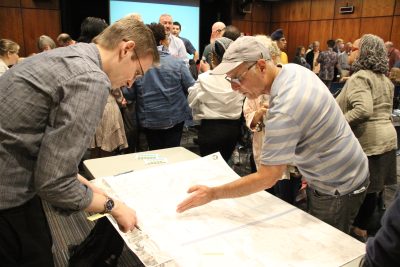White Plains Community Shares Ideas on Roadway Safety Improvements
News Based on facts, either observed and verified directly by the reporter, or reported and verified from knowledgeable sources.
Ankita Rathi heard a lot of similar concerns during a public meeting last week focused on road safety in White Plains.
“I wish we could cross before the car gets there,” the traffic consultant recalled hearing from multiple attendees during the Oct. 23 late evening session inside the White Plains Library auditorium.
Their concerns revolved around what’s formally known as the “leading pedestrian intervals,” and ultimately wanting more time allotted to pedestrians to cross a roadway or intersection before drivers get the go-ahead.

Those larger time windows may be one of many improvements coming to White Plains as a result of the input received from some 50 individuals last week, and could be part of the future safety plan being developed by the city.
Policy, infrastructure and education are all on the table to be included as part of the recommendations in the plan known globally as “Vision Zero,” according to Alanna Moran, another of city’s traffic consultants. The plan’s guided by the idea that fatal and serious accidents are preventable and “unacceptable.”
The list of recommendations also could include speed limit changes, raised crosswalks, or no turn on red signs, but even multi-million-dollar undertakings, for instance creating center turn lanes, said Moran.
The plan’s creation is supported by $400,000 in federal funding through the Safe Streets and Roads for All Program. Once crafted, the document would unlock “implementation” funding for those larger projects.
“Your participation tonight is so helpful in creating what we need to make a good application for the implementation,” Mayor Thomas Roach told attendees. “At the end of this, we’re going to have some great ideas and plans to move forward with.”
In addition, Ryan Wolf, another traffic consultant, revealed the roadways of focus are around City Center, The Westchester, East View Neighborhood, White Plains Hospital, Transportation Center, Public Library, Downtown, South White Plains (Mamaroneck Avenue and Road, and Bryant Avenue) and North Broadway.
Those areas were depicted on maps, along with images of possible improvements, giving attendees the opportunity to reference specific areas as they went about sharing their ideas with consultants and local officials.
The consultants also shared that the roadways with the most crashes were Mamaroneck Avenue, Maple Avenue, Main Street, Westchester Avenue, Central Avenue, North Broadway, Hamilton Avenue, Tarrytown Road, Bryant Avenue, East Post Road, South Lexington Avenue and Lake Street.
Safety improvement recommendations will be specific to White Plains and could be formalized for public consumption as soon as February or March, said Moran. The actual safety plan could be finalized by April or May.
“This information should be widespread,” said Enrico Rodriguez, one of the attendees. “The more people can participate, the more their opinions will be included.”
Rodriguez is worried about crossing the street too. His spouse pointed out that more traffic cameras and speed enforcement are needed: “It’s crazy, especially during the weekends, Broadway is like a racetrack.”
Marty Rudow attended with his wife Nancy Ehrlich and neighbor Sheri Jordan.
They didn’t see Quinby Avenue on the posted maps, a cut-through road from West Post Road to the Bronx River Parkway and near their Fisher Hill neighborhood.
But they still felt their thoughts were heard. They pinpointed a hill there where visibility is limited for pedestrians, drivers and the school children who walk there.
“That’s been an issue ever since we moved there,” Rudow said.
A recent reduction in the speed limit to 25 miles per hour helped, they acknowledged, but they felt more could be done.
“We were also talking about the explosion of distributed and aggressive driving, but that’s not unique to White Plains,” he added.
Ken Kraetzer, whose late wife Kerri was the victim of a pedestrian accident, feels it’s all about “building public awareness,” especially as the sun goes up and down.
“You got to be careful when crossing urban streets and can’t take for granted that drivers will stop,” he said.
Wearing reflective vests could be part of the answer. But he’s also got some other tips.
“Only use one ear pod at a time,” he said. Or drivers looking to cross a road or make a turn need to “look to the left curb, the right one and then then left one again.”
Other thoughts, written on Post-It notes during the event, pushed for more police to direct traffic in construction zones and more effective signage for pedestrian crossing, as well as the elimination of areas of low visibility and ones prone to double parking.
Some thoughts, coming from initial survey results, found people wanted an expansion of the safe bike lanes and sidewalk network, as well as more infrastructure geared toward people with disabilities.
More information about Vision Zero can be found at cityofwhiteplains.com/Vision-Zero. The survey can be accessed at: www.surveymonkey.com/r/WhitePlainsVisionZero.

Andy Milone was a freelance reporter who wrote for The White Plains Examiner from May 2024 until January 2025. The Chatham, New Jersey native and Gettysburg College graduate previously worked as a staff reporter for The Waterloo-Cedar Falls Courier in Iowa, Pine Barrens Tribune in New Jersey and The Shippensburg News-Chronicle in Pennsylvania.
